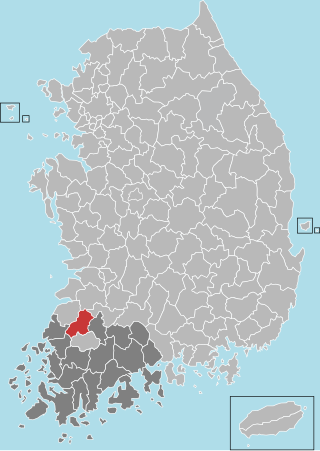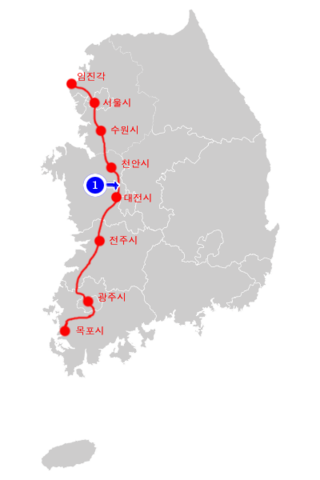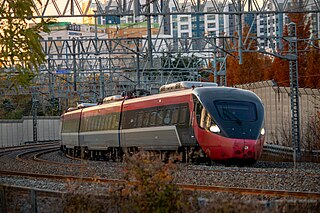
Samcheok is a city in Gangwon-do, South Korea. To the west are the Taebaek Mountains, which form a high flat plain of more than 1,000 meters, and to the east, the coastal plain slopes sharply. It borders Donghae City in the north, Uljin County in Gyeongsangbuk-do in the south, and Taebaek City in the west. It covers an area of 1,185.86 km2 and has a coastline of 58.4 km.The city hall is located in Gyo-dong, and the administrative area includes 2 districts, 6 villages, and 4 dongs. The tree symbolizing the city is the zelkova, the bird is the seagull, and the flower is the azalea. Samcheok has the lowest population density of any autonomous city in Korea.

Jangseong County is a county in South Jeolla Province, South Korea.

Gwangju Airport is an airport in the city of Gwangju, South Korea and is managed by the Korea Airports Corporation. In 2018, 1,986,125 passengers used the airport. This airport is planned to close when Muan International Airport becomes more established. Because Gwangju Airport is sharing with military, taking photograph or video of apron, runway and military facility is strictly prohibited.

The Mugunghwa-ho (Korean: 무궁화호) is a class of train operated by Korail, the main railway operator of South Korea. Mugunghwa trains are Korail's slowest tier of trains stopping at a number of towns and villages, and operating over a number of lines that are not served by other trains. Journey times are generally twice that of KTX trains and 25% longer than ITX express trains.

The Cheolli Jangseong or Great Wall of Korea may refer to either of two massive fortifications built between medieval Korea and the Chinese to the west and other tribes to the north. The first is a 7th-century network of military garrisons built by Goguryeo, one of the Three Kingdoms of Korea. These are now located in Northeast China. The second is an 11th-century wall built by Korea's Goryeo dynasty, now located in North Korea.
Jeongjong of Goryeo, personal name Wang Hyŏng, was the 10th king of Korea's Goryeo dynasty. He was the second son of King Hyeonjong, and the younger brother of King Deokjong. At the age of four in 1022, he was made Naesaryeong, a position of high rank, and designated the Prince of Pyongyang.
Deokjong of Goryeo, personal name Wang Hŭm, was the 9th king of the Goryeo dynasty of Korea. The son of King Hyeonjong, he was confirmed as Crown Prince in 1022. During his reign, the compilation of national histories that was started during King Hyeonjong's reign was completed, and under the advice of General Kang Kam-ch'an the construction of the second Cheolli Jangseong began.

Yodŏk County is a county in South Hamgyŏng province, North Korea. Originally part of Yŏnghŭng county, it became a separate entity as part of the 1952 reorganization of local government.

The 2015 Summer Universiade was a Universiade held in the city of Gwangju, South Korea. It took place from July 3 to July 14, 2015. Gwangju also hostes the group matches of the 2002 FIFA World Cup.

National Route 1(Korean: 국도 제1호선; RR: Gukdo Je Il Hoseon) is a national highway in South Korea. It connects Mokpo, South Jeolla Province with the city of Paju in Gyeonggi-do. Before the division of the Korean peninsula, the highway ran until Sinuiju, North P'yongan Province, in present-day North Korea.

Republic of Korea Army Infantry School(육군보병학교) is a college located in Jangseong, South Korea.
Republic of Korea Army Engineer School is a Republic of Korea Army military engineering school located in Jangseong, South Korea.
The 7.30 by-elections were held in South Korea on 30 July 2014. 15 seats to the National Assembly of South Korea were contested while re-election occurred for 1 seat to the Municipal Council of Suwon.
Table tennis was contested at the 2015 Summer Universiade from July 6 to 13 at the Jangseong Hong Gil-Dong Gymnasium in Jangseong, South Korea. Men's and women's singles, men's and women's team, and men's, women's, and mixed doubles events was contested.

The Intercity Train eXpress-Saemaeul abbreviated as ITX-Saemaeul (Korean: ITX-새마을) is a class of train operated by Korail, the national railroad of South Korea, it was introduced on May 12, 2014, to replace the Saemaeul-ho. The new ITX-Saemaeul trains have a faster average speed of 150 kilometers per hour. The name was taken from the Saemaul Undong after a public competition to determine the new train's name.

Korean fortresses are fortifications constructed by Koreans since the Three Kingdoms of Korea period. Koreans developed a unique and distinct fortress tradition. Korea, beginning with Goguryeo, has been called "a country of fortresses"; almost 2,400 mountain fortress sites have been found in Korea.
National Route 24 is a national highway in South Korea connects Sinan County to Nam District, Ulsan. It established on 31 August 1971.
Local Route 15 Oenaro-do–Yeonggwang Line is a local route of South Korea that connects Bongnae-myeon, Goheung County, South Jeolla Province to Hongnong-eup in Yeonggwang County, South Jeolla Province.

The Battle of Jangseong Hwangryong River, or the Battle of Hwangryong River, was an 1893 conflict in Korea between the Donghak Peasant Army and Hong Gye-hun's army. During the journey from Yeonggwang, Hampyeong, and Muan to Jangseong, the Donghak Peasant Army, which had been advancing triumphantly everywhere they went, finally encountered Hong Gye-hoon's military forces that had chased after them and engaged in a battle in Jangseong.













